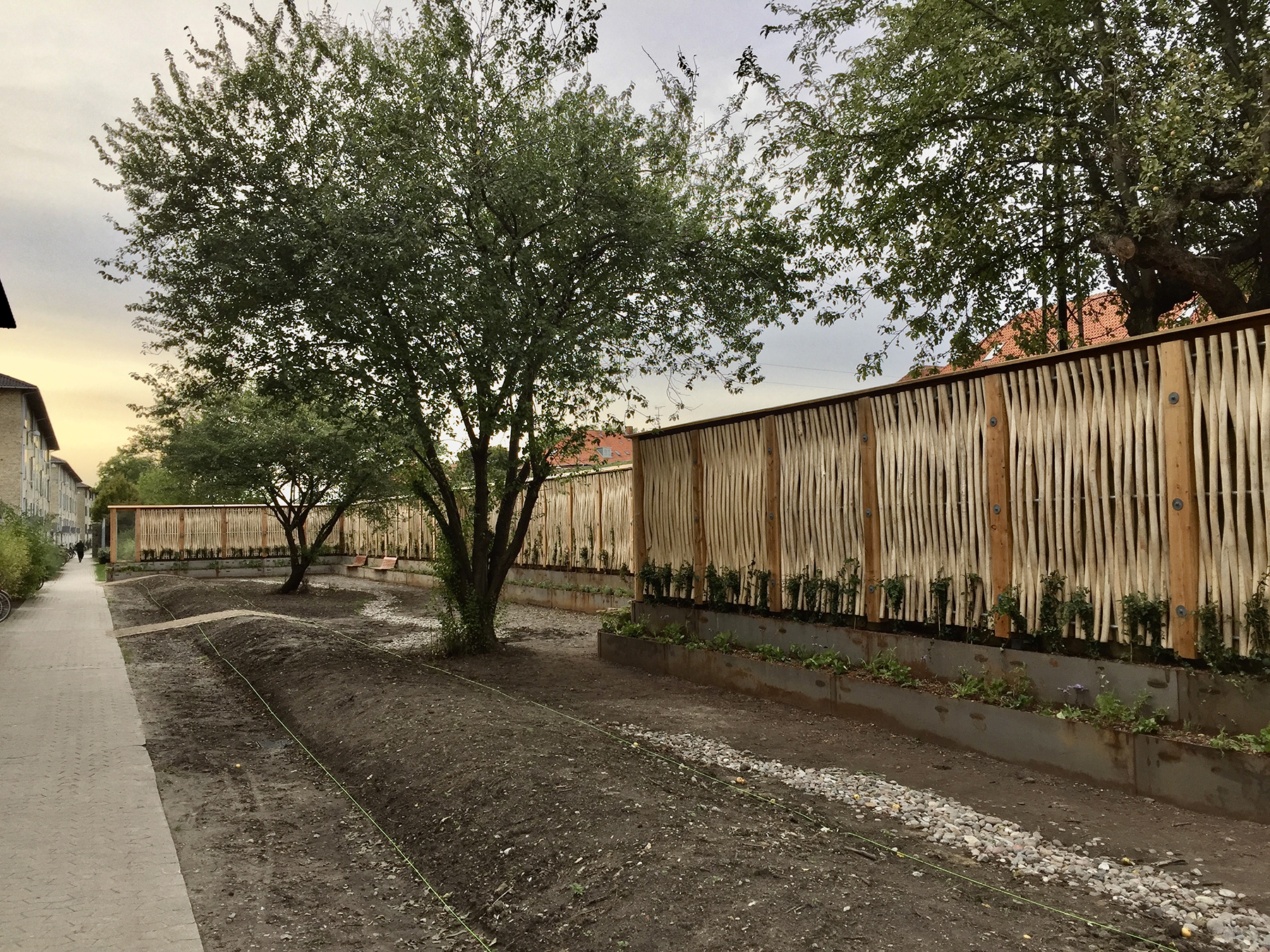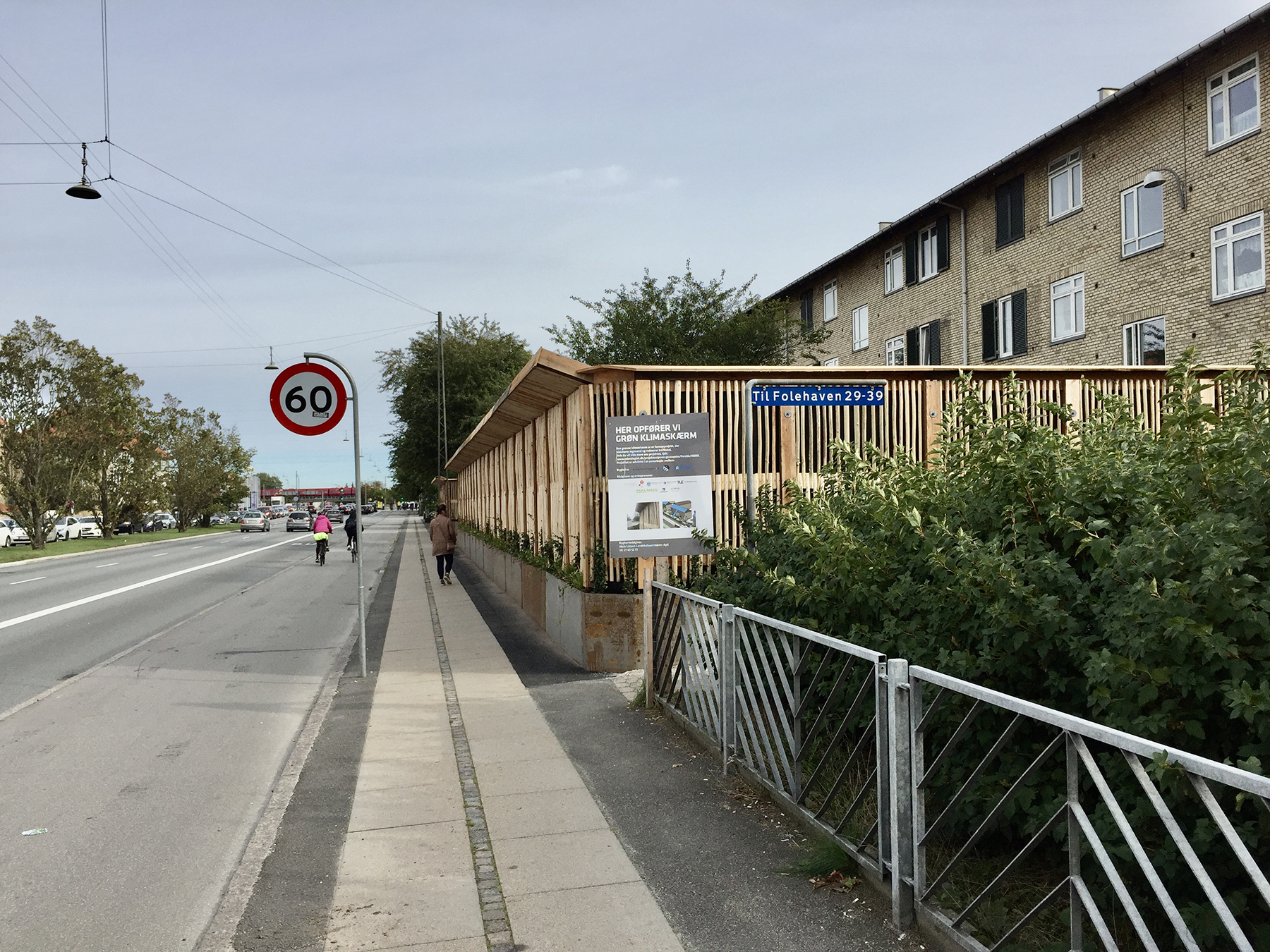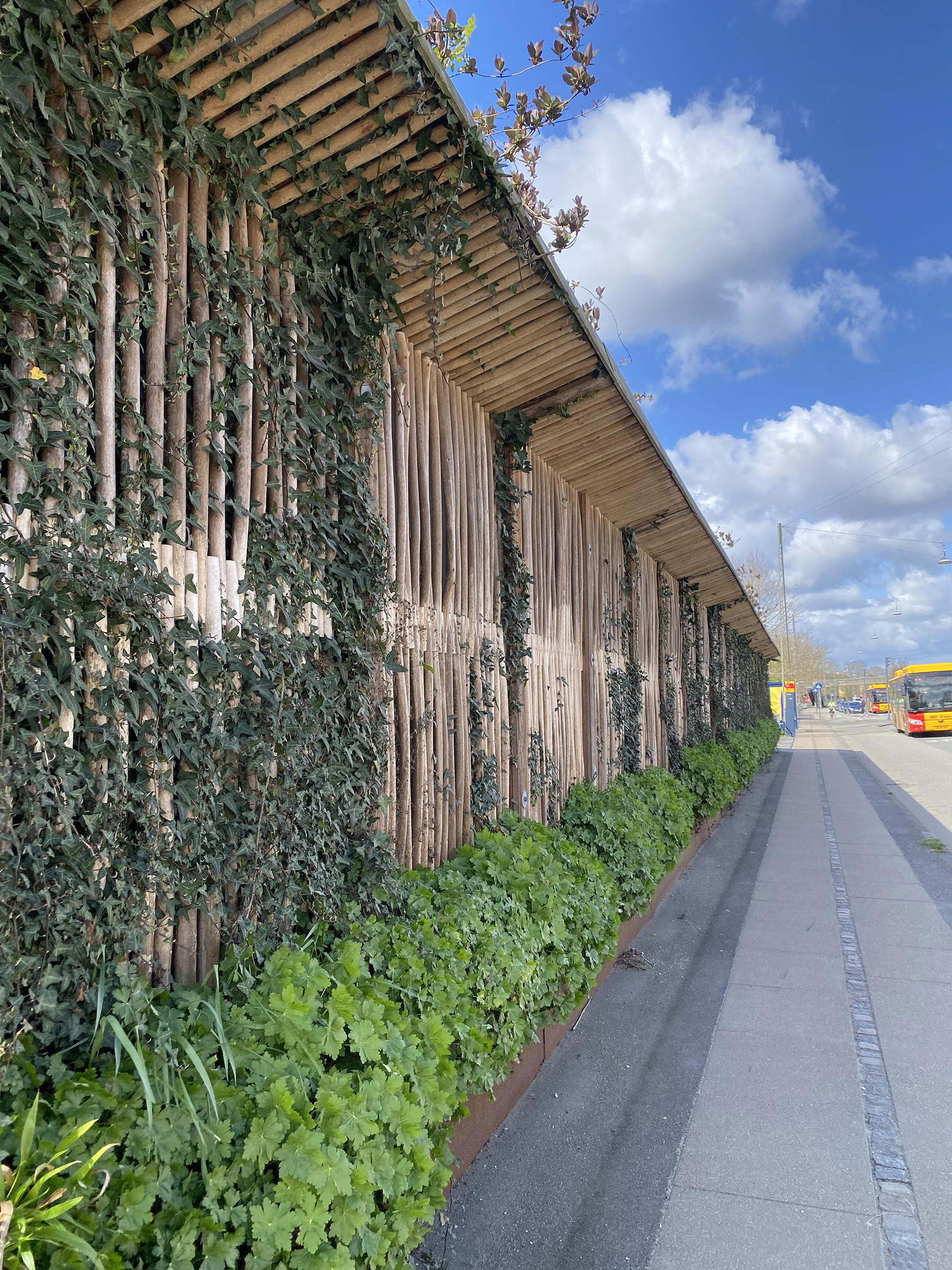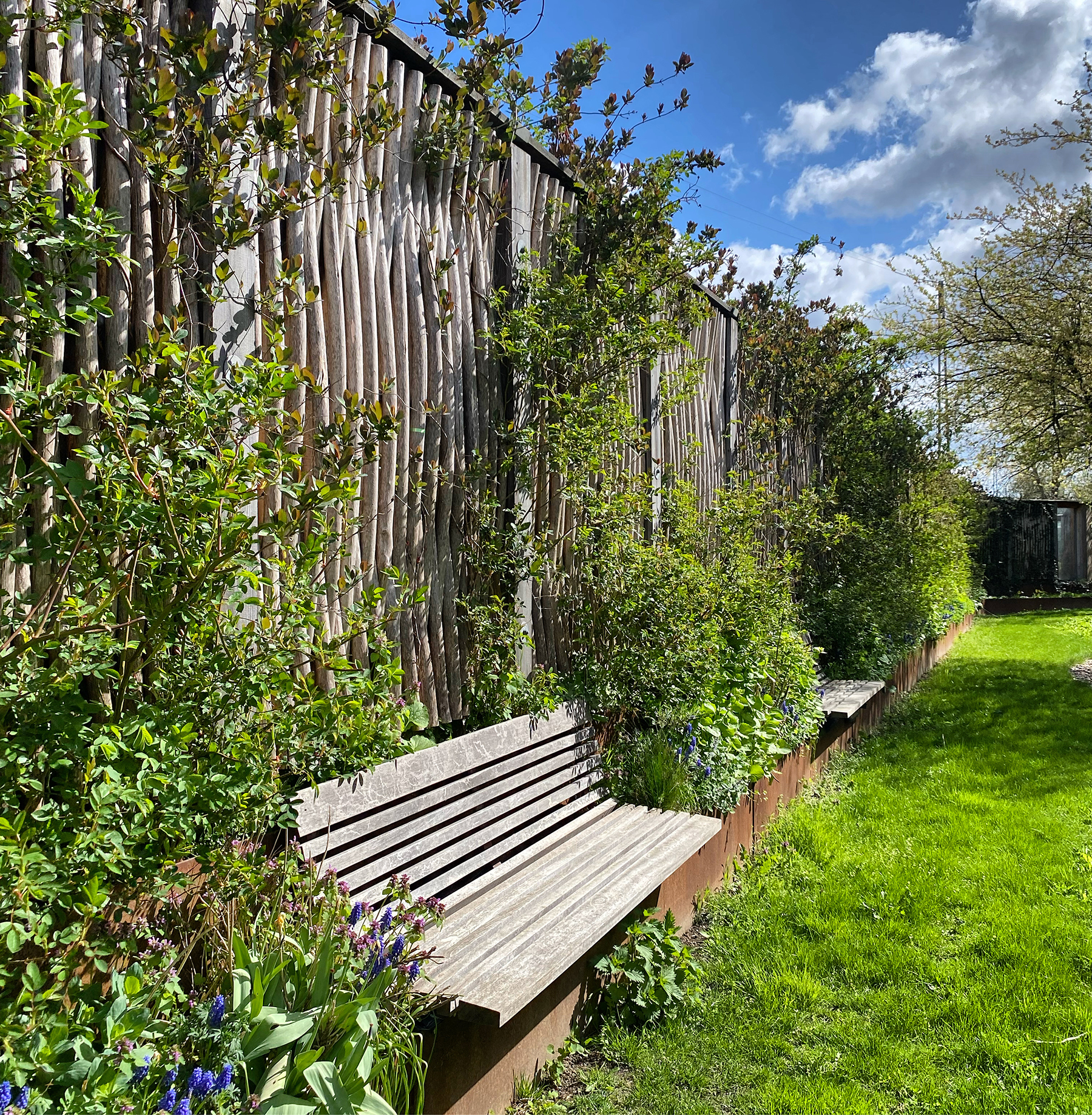By Jay Landers
Urban areas increasingly must cope with growing volumes of stormwater runoff, whether because of greater precipitation, added impervious surfaces, or both. Looking to limit the extent to which runoff enters collection systems that often are aging or inadequate, cities are seeking ways to manage stormwater as close to the source as possible, including through nature-based solutions. Because space constraints can preclude or limit the use of such solutions, ever-more ingenious measures are needed.
In Denmark, researchers and practitioners have devised a multifaceted solution that combines stormwater management, noise reduction, urban beautification, and privacy. Known as the Green Climate Screen, the approach conveys rooftop runoff to the top of a nearby vertical noise barrier, which contains highly absorbent material that soaks up the water and releases it later via evaporation. Although an elegant, sustainable solution, only one such system has been installed to date, highlighting the opportunities and challenges associated with developing and deploying new approaches for existing stormwater challenges.
Water as a resource
Last year saw record rainfall in Denmark, exacerbating the need for improved stormwater management, according to a Jan. 25 news release from the University of Copenhagen. In response, some Danish cities are looking to expand their collection systems to accommodate the increasing rainfall, according to the news release.

However, failing to evaluate greater use of nature-based solutions would represent a significant missed opportunity, said Marina Bergen Jensen, Ph.D., a professor of landscape architecture, planning, and design in the University of Copenhagen’s department of geosciences and natural resource management, in the news release. “It’s as if we only see one side of the climate extreme – too much water,” Jensen said. “We forget that there can also be far too little water and that water is a resource.
“Instead of expanding our sewers and making giant concrete tunnels and basins, which in themselves contribute to global warming, we should manage stormwater locally around individual buildings and roadways. In this way, we can become more resilient against both flooding and drought while relieving the pressure on our sewer systems.”
Vertical storage system
As an example of the type of nature-based solution that urban areas should consider, Jensen points to the Green Climate Screen, a project that she shepherded from concept to creation. Constructed in 2019 in the Copenhagen district of Valby, the project consists of an approximately 3.2-meter-high, 72-meter-long fence that was designed to reduce noise from an adjacent roadway while also capturing stormwater from the roof of a nearby building. In essence, the fence serves as an attractive yet highly functional noise barrier and a vertical stormwater storage system that supports an abundance of wildflowers and other vegetation at its base.
The pump-free, gravity-based system conveys runoff from the roof of an adjoining apartment building via a downspout and through an underground pipe that extends to the top of the barrier. A small drainage hole in the underground pipe ensures that it remains free of water during winter, when it otherwise would freeze and crack.

At the top of the barrier, a distribution gutter allows the water to flow over the entire length of the barrier and percolate downward into the center of the structure, where it is absorbed by a rock-based material known as mineral wool that is commonly used as insulation. Water held by the mineral wool either evaporates or, when soaking wet, is released into an underlying chamber that contains soil and supports vegetation. Flows exceeding the storage capacity of the barrier are directed to a nearby green area surrounded by a dike, thereby serving as a detention basin.
A series of wood posts and steel rods hold the mineral wool in place. A facade made of willow branches is used to soften the appearance of the barrier, lending it the look of a garden fence. The branches were provided by PileByg A/S, a company whose name translates to “willow built.” PileByg constructs noise barriers, screens, and fences using willow branches grown by the company because the natural material requires little in the way of carbon emissions to produce, says Vibe Gro Falk, a project manager for PileByg, which constructed the Green Climate Screen. “We want to try to make as sustainable a product as possible,” Falk says.
The top of the barrier also includes an overhanging roof element that is designed to further reduce noise from the adjacent roadway. The roof element contains a soil-like substrate to facilitate the growth of vegetation. The barrier is connected by adhesive anchors to a foundation comprising reinforced-concrete piles, which are hidden from view by steel plates used to form the plant beds at the base of the structure.
The vertical nature of the Green Climate Screen is what sets it apart from traditional nature-based stormwater management solutions that require significant space, Jensen told Civil Engineering Online. Such solutions are “based on digging and removal of soil into a basin, infiltration trench, rain garden, or curb extension,” she says. “That whole exercise of digging soil away can be avoided if we can use the area as it is and just pack the water above ground. I think that’s a really, really big advantage.”
Good performance to date
The Green Climate Screen has 144 square meters of surface area containing the absorbent material to manage stormwater runoff from a mere 240-square-meter rooftop. “In a way, you can say it’s over-dimensioned since the length was given from the noise barrier criteria,” Jensen says.
The mineral wool within the Green Climate Screen can absorb and evaporate the first 15 millimeters of a rain event. “That’s, of course, if the mineral wool is dry when it starts to rain,” Jensen says. “If it contains antecedent water from previous events, it will absorb less before drip-through and infiltration takes over.”

During larger rain events, water will drip down from the mineral wool to the planting box that extends the full length of the screen. Because it is open at its base, the planting box facilitates infiltration into the ground along the length of the system, says Jensen. In this way, the Green Climate Screen can accommodate runoff from rain events having a recurrence interval of up to 50 years, she notes. Runoff from larger events is diverted to the adjacent grassy area, enabling storage of at least 150 millimeters of rain. “It’s a very secure system,” Jensen says.
Initial efforts to monitor the performance of the mineral wool in terms of absorption and evaporation rates were not fully successful due to inadequate moisture probes, Jensen says. “But we are happy with the way it works based on observations,” she notes. That said, Jensen says she plans to set up a test system “so we can monitor how much water it is absorbing and how quickly it is releasing that water.”
Multiple benefits
As a noise barrier, the Green Climate Screen has surpassed expectations, says Tim Larsen, the owner of TL Engineering, which helped design the project. “There’s 50,000 vehicles running every day, just at the other side of the noise barrier,” he says. That volume of traffic generates a significant amount of noise, which the barrier dampens effectively. Upon entering the area served by the Green Climate Screen, “there’s more or less no noise compared to what you heard from the other side,” Larsen says. “It’s really amazing.”
Unlike traditional noise barriers, the Green Climate Screen has not attracted the attention of graffiti artists. “We don’t see any graffiti,” likely because of the willow facade, Falk says. Not having to spend money to remove graffiti is an “added value” provided by the screen, she says.
As for other benefits, the Green Climate Screen makes “greenery possible for those living in the city,” Falk notes. The vegetation growing at the base of the screen provides habitat and promotes biodiversity, while benches along the screen afford an opportunity for residents to enjoy the space. For these reasons, the screen is a “win-win in so many ways,” she says.

All told, the project cost approximately $500,000 to construct, Larsen says.
However, future versions of the system, which has a design life of at least 37 years, likely would cost around one-third the cost of the pilot project, thanks to lessons learned from the pilot, Jensen says.
Although more expensive than a conventional noise barrier, the Green Climate Screen could potentially help a municipality reduce other costs, such as having to install new or upgrade existing drainage infrastructure to accommodate stormwater runoff, Falk says. “There is nothing more expensive than to dig up a road and put down bigger pipes,” she says.
Complicating factors
Given the many benefits of the Green Climate Screen, why has only one been constructed? In part, the dual nature of the screen can create certain complications, Jensen says. “It’s difficult to find places where we need a noise barrier and, at the same time, we want to manage stormwater with these nature-based solutions,” she says.
At least in Denmark, combining the features of a noise barrier and a stormwater management practice also complicates matters when it comes to securing government funding, Falk says. The different features involve “two different decision-makers with two different budgets,” she says. “In quite a few municipalities, they don’t speak to each other. So, it is very, very difficult.”
Cost is another reason, though ways exist to address that concern, Jensen says. For example, a smaller structure that is not intended for use as a noise barrier would not cost as much, she notes. “If we didn’t have to make it 3 meters tall but only 1 meter, it could be cheaper.”
Later this year, Jensen plans to begin testing another vertical approach to stormwater management that relies on soil and vegetation rather than mineral wool. To be located on the property of a 2.2-hectare site in Copenhagen owned by a nonprofit housing entity, the demonstration project will convey roof runoff from buildings and distribute it across the top of a novel swale-dike design that is planted with attractive shrubs and perennials. “Then the soil is the absorbing material instead of the mineral wool,” Jensen says.
Other potential goals for the demonstration project include addressing the urban heat-island effect and water harvesting for use on-site. “My expectations are quite high on this, especially in existing built-up areas where the space is so limited,” Jensen says.
This article was published by Civil Engineering Online.



